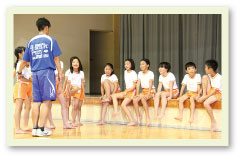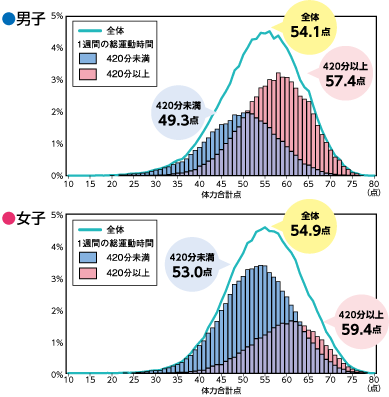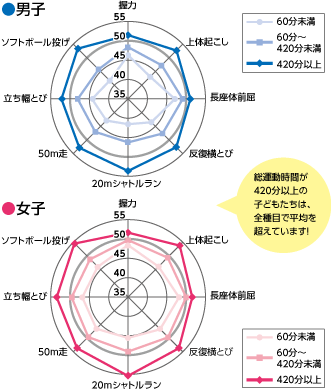SPORTS YOKOHAMA Vol.39 : Feature(1/3)

“Children’s physical strength is declining!”
Haven’t you ever heard a phrase like this?
Children used to play outdoors after school with peers and older boys and girls in the neighborhood until sunset. The sight of kids playing outdoors was a familiar one in the past. With huge changes taking place in social conditions and the environment surrounding children, however, such a sight has become rare.
By playing outdoors, children automatically increased their physical strength in terms of stamina and agility and acquired athletic abilities of running, jumping, climbing and throwing. Gone with the familiar sight in the neighborhood are opportunities for children to become physically strong spontaneously.
With these opportunities decreasing dramatically in our daily lives, parents now have a vital role to play in helping children gain in physical strength. The reality is, though, most parents are clueless about what to do.
This volume of Sports Yokohama reports on the present situation of sports for children and the purpose of the New Physical Test while at the same time offering information about sporting events, programs, classes and facilities for parents and children.
Autumn is the best season for sports. Why don’t we start thinking about ways to help children boost their physical strength?
Information provided by: Sports Club Whistle
Written and photos provided by: Hiroyuki Yoshiyama (Yokohama Sports Association)
 The Sport Basic Plan, published in March 2012 by the Ministry of Education, Culture, Sports, Science and Technology in response to the Basic Act on Sports enacted in August 2011, says that one of its goals is to enhance the physical capabilities of children so that, within the next ten years, children’s physical strength exceeds the levels of around 1985 when it was considered at its peak.
The Sport Basic Plan, published in March 2012 by the Ministry of Education, Culture, Sports, Science and Technology in response to the Basic Act on Sports enacted in August 2011, says that one of its goals is to enhance the physical capabilities of children so that, within the next ten years, children’s physical strength exceeds the levels of around 1985 when it was considered at its peak.
The physical strength levels of today’s children are still lower than those of children in late 1980. Results of the annual New Physical Tests conducted in recent years, however, show that total test scores have stopped dropping and are starting to improve gradually.
The tests have revealed a new problem, though. Children are now polarized into two groups: those who exercise actively and those who don’t. There are an increasing number of children who are not into physical activity.
According to the results of the national survey of physical fitness, athletic performance and exercise compiled in 2012 by the Ministry of Education, Culture, Sports, Science and Technology, 10.9 percent of elementary school boys, or about one in ten, and 23.9 percent of elementary school girls, or about one in four, exercise for less than 60 minutes a week in total. A look at the relationship between the total weekly exercise time and the total score of the physical test show that children with shorter total weekly exercise time (less than 420 minutes), whether boys or girls, have lower total scores (Figure 1).
This is also true when the New Physical Test results are compared by type of exercise. Children with shorter exercise time, whether boys or girls, score lower in every type of exercise than those who exercise longer (60 to less than 420 minutes/420 minutes or more). As suggested by the fact that the gaps are particularly evident in ball throwing and 20-meter shuttle run tests (Figure 2), there is clear polarization between children who frequently exercise and those who seldom exercise in terms of physical fitness and athletic performance, which is presenting a new problem.
Since physical strength is the basis for every kind of activity, it is important to start developing it in an active, sound manner from childhood. Parents therefore need to make sure that their children develop their physical strength in a well balanced way.

Figure 1 Relationship between the total weekly exercise time and the total physical test score

Figure 2 Comparison of test scores by type of exercise based on the total weekly exercise time
Source: Results of the national survey of physical fitness, athletic performance and exercise in 2012

“Children’s physical strength is declining!”
Haven’t you ever heard a phrase like this?
Children used to play outdoors after school with peers and older boys and girls in the neighborhood until sunset. The sight of kids playing outdoors was a familiar one in the past. With huge changes taking place in social conditions and the environment surrounding children, however, such a sight has become rare.
By playing outdoors, children automatically increased their physical strength in terms of stamina and agility and acquired athletic abilities of running, jumping, climbing and throwing. Gone with the familiar sight in the neighborhood are opportunities for children to become physically strong spontaneously.
With these opportunities decreasing dramatically in our daily lives, parents now have a vital role to play in helping children gain in physical strength. The reality is, though, most parents are clueless about what to do.
This volume of Sports Yokohama reports on the present situation of sports for children and the purpose of the New Physical Test while at the same time offering information about sporting events, programs, classes and facilities for parents and children.
Autumn is the best season for sports. Why don’t we start thinking about ways to help children boost their physical strength?
Information provided by: Sports Club Whistle
Written and photos provided by: Hiroyuki Yoshiyama (Yokohama Sports Association)
 The Sport Basic Plan, published in March 2012 by the Ministry of Education, Culture, Sports, Science and Technology in response to the Basic Act on Sports enacted in August 2011, says that one of its goals is to enhance the physical capabilities of children so that, within the next ten years, children’s physical strength exceeds the levels of around 1985 when it was considered at its peak.
The Sport Basic Plan, published in March 2012 by the Ministry of Education, Culture, Sports, Science and Technology in response to the Basic Act on Sports enacted in August 2011, says that one of its goals is to enhance the physical capabilities of children so that, within the next ten years, children’s physical strength exceeds the levels of around 1985 when it was considered at its peak.
The physical strength levels of today’s children are still lower than those of children in late 1980. Results of the annual New Physical Tests conducted in recent years, however, show that total test scores have stopped dropping and are starting to improve gradually.
The tests have revealed a new problem, though. Children are now polarized into two groups: those who exercise actively and those who don’t. There are an increasing number of children who are not into physical activity.
According to the results of the national survey of physical fitness, athletic performance and exercise compiled in 2012 by the Ministry of Education, Culture, Sports, Science and Technology, 10.9 percent of elementary school boys, or about one in ten, and 23.9 percent of elementary school girls, or about one in four, exercise for less than 60 minutes a week in total. A look at the relationship between the total weekly exercise time and the total score of the physical test show that children with shorter total weekly exercise time (less than 420 minutes), whether boys or girls, have lower total scores (Figure 1).
This is also true when the New Physical Test results are compared by type of exercise. Children with shorter exercise time, whether boys or girls, score lower in every type of exercise than those who exercise longer (60 to less than 420 minutes/420 minutes or more). As suggested by the fact that the gaps are particularly evident in ball throwing and 20-meter shuttle run tests (Figure 2), there is clear polarization between children who frequently exercise and those who seldom exercise in terms of physical fitness and athletic performance, which is presenting a new problem.
Since physical strength is the basis for every kind of activity, it is important to start developing it in an active, sound manner from childhood. Parents therefore need to make sure that their children develop their physical strength in a well balanced way.

Figure 1 Relationship between the total weekly exercise time and the total physical test score

Figure 2 Comparison of test scores by type of exercise based on the total weekly exercise time
Source: Results of the national survey of physical fitness, athletic performance and exercise in 2012
 ハマスポ
ハマスポ
 お知らせ&トピックス
お知らせ&トピックス
 ページトップへ戻る
ページトップへ戻る ページトップへ戻る
ページトップへ戻る

